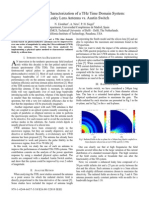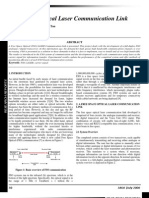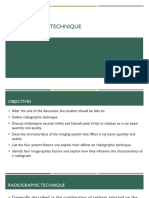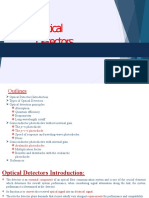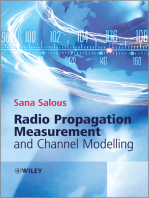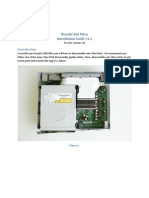Applied Lasers: Although Basically Research Certain Specific Communication or For Communication Across The
Applied Lasers: Although Basically Research Certain Specific Communication or For Communication Across The
Uploaded by
Taha Al-abedCopyright:
Available Formats
Applied Lasers: Although Basically Research Certain Specific Communication or For Communication Across The
Applied Lasers: Although Basically Research Certain Specific Communication or For Communication Across The
Uploaded by
Taha Al-abedOriginal Title
Copyright
Available Formats
Share this document
Did you find this document useful?
Is this content inappropriate?
Copyright:
Available Formats
Applied Lasers: Although Basically Research Certain Specific Communication or For Communication Across The
Applied Lasers: Although Basically Research Certain Specific Communication or For Communication Across The
Uploaded by
Taha Al-abedCopyright:
Available Formats
Applied lasers
Although lasers are basically in the research stage, certain specific types
ranging, and detection applications
have recently evolved as useful electronic components for communication,
communication macrodimensions of space. Two short-distance voicecommunication systems are described-one requiring careful boresight alignment and the other involving a
The laser has been found useful for short-distance
or for communication across the
James Volliner
Radio Corporation of America
alignment. A laser range-measuring system has been developed that can make distance checks for aircraft refueling or for measuring the altitude of spacecraft landing on the moon. The principles of ranging can also be applied to selective viewing, maintaining a separation of vehicles moving along a set path, or selectively counting certain-sized objects. The laser also can be used in a simple intrusion alarm since its narrow beam can be reflected over a very long distance with little spreading.
megaphone-like broad-beam laser that needs little
FIGURE 1. Experimental model of laser communication system using two GaAs injection lasers. It operates in a pulsed mode, at 8000 pulses per second, and has a bandwidth of 3 kHz and a range exceeding 5 km. Detector is a silicon photodiode.
'<
In today's society, the central " . theme is communication -by code, by word, by printed page, by picture. It is not surprising, therefore, that efforts to apply the laser to communication came immediately upon its invention. In a sense, the application preceded the invention, inasmuch as the need for greater bandwidths was prominent in the motivation of laser research. If we classify our communication requirements on the basis of range, we find that lasers can be helpful at the range extremities-that is, for distances less than about 15km and for those greater than 80 million km. The requirement is admirably met by a pulsedvshort-range l injection-laser system.' An injection-laser diode operable at room temperature with modest current (first reported by Nelson et al.2) has been particularly useful. It requires ~~. ~~~, ~only 10 amperes to lase; it is not an eye hazard (the pulse energy can be less than 0.2 4J); it has a resistance of only 0.3 ohm and hence can be operated serially; it is physically small (0.075 by 0.075 by 0.18 mm); and radiates just outside the visible spectrum (9020 A). The transmitter in Fig. 1 employs two such lasers and appears to fill the need for a small, lightweight, private voice-communication link. Because it employs pulsed frequency modulation, the system is insensitive to fluctuations in transmission characteristics of the atmosphere. The low energy requirements permit operation of the system from small batteries for up to 2 '2 hours. Because the transmitter beam width is small (8 mrad), the system
IEEE
66
spectrum JUNE 1967
must be aligned by means of telescopes, which are boresighted with the laser. Narrow beam width is simultaneously a burden and an asset. It complicates the alignment of the transmitter and receiver; but it does provide low power drain and great privacy. Operation at 9020 A enhances this privacy by virtue of its invisibility. Furthermore, the responsivity of silicon photodiodes at this wavelength is orders of magnitude higher than that of photomultipliers. Hannan and Bordogna3 have shown that in an amplifier-noise-limited system, this higher responsivity of the photodiode results in a significantly better signal-to-noise ratio than could be achieved with a photomultiplier in the infrared region. Restated, at 9020 A, for a given signal-to-noise requirement, the photodiode system demands less transmitter power than a multiplier phototube system when amplifier-noiselimited. A whole series of practical advantages accrues from the use of a photodiode: it is no longer necessary to have a .high-voltage supply; it is no longer necessary to include a narrow-band optical filter; and it is no longer necessary to restrict operation to after sunset. In addition, the detector itself is small and rugged. In contrast to this narrow-angle system, a wide-angle communication link that employs the same components has also been developed (Fig. 2). This link utilizes a kind of laser megaphone. Through the use of four laser diodes without lenses, a 15-degree beam is formed. Such a wide beam width virtually eliminates any problems associated with alignment. Although the range is greatly reduced (100 meters), this kind of system could be very useful during refueling operations in aircraft or in docking operations in space. Both of these injection-laser systems operate at a pulse rate of 8 kHz,* with a duty cycle of 0.1 percent and a modulation bandwidth of 3 kHz. Each of these links is built around the following general scheme. The transmitter microphone output is amplified and used to vary the repetition rate of the pulses from the laser; thus the system is pulse frequency modulated. In the receiver, a photodiode output is amplified, limited, and demodulated. After additional amplification, the audio signal is brought out through earphones or a
Figure 3 shows still another member of this class of laser voice transmitter. This particular unit was part of the Gemini 7 mission, and it is perhaps the only laser system that has had to pass space qualification tests. Four laser diodes were employed in it, each with its own lens. Actually, in this transmitter the laser and lens formed a subassembly. Since the time the first unit was built, a laser lens subassembly that can be replaced as easily and as quickly as a flashlight bulb has evolved. The far-field patterns of the GT-7 transmitter were oriented to illuminate a square, approximately 0.8 km on a side, from an altitude of 240 km. The peak output power of this 2.35-kg unit was 25 watts. This range of hundreds of kilometers is certainly not within the extremes iden-
FIGURE 2. Voice link employing four lasers. Natural divergences of the diodes have been combined to produce a transmitter with a 15-degree beam without lenses. In combination with the wide-angle the use of receiver, it has a range of 100 meters. In this system a light on top of the receiver indicates alignment, and no telescopes are necessary.
speaker.
The repetition rate of 8 kHz was achieved with selected units.
cxperimentally
67
Vollmer-Applied lasers
tified earlier. The objective, however, was not to provide an operational communication system for the spacecraft. A microwave link, which is far more suitable for this application, accomplished that function. The goal of the laser experiment was to gain experience and information for more ambitious deep-space links. A program in which sunlight was used to pump a crystal laser was being carried out simultaneously.4'5 The requirement was to build a laboratory model, sunpump it, modulate it at television rates, and make a technical assessment of an optimum system for transmitting television information in real time over a range of 80 million km. In the laboratory system built, an equatorial mount with a clock drive permitted extended operation (up to 'A2 hour in gusty wind). A mirror focused over 200 watts onto the laser, well above the 25-watt threshold for YAG. Output power was 100 mW on a continuous basis. The material on which most of the studies were performed was yttrium aluminum garnet, doped with trivalent neodymium and chromium ions.', Figure 4 is a photograph of a television test pattern transmitted across the laboratory by such a sun-pumped laser. Although it is true that all of the components necessary for deep-space laser television links are not yet available, there appears to be no fundamental obstacle to obtaining them. The potential advantages that such
links offer in size and weight seem to justify the effort required.
l ~ . Laser ranges If communication has been the dominant application for lasers, ranging is certainly a close competitor. As in the case of communication, ranging applications may be FIGURE 3. Transmitter developed to be flown on the Gemini 7 mission. lt employed four Inlection-laser diodes in conveniently classified on the basis of distance. In general, series, with a total peak power of 25 watts. Dimensions earthbound laser-ranging systems are limited by local were approximately 7.5 X 13 X 20 cm. Pulse duration was atmospheric conditions. A typical value of range routinely 70 ns, with two repetition rates available: 8000 and 100 measured is 20 km or less. Ruby crystal and, more repulses per second. Operating time was 40 minutes for cently, neodymium-doped yttrium aluminum garnet voice, 150 minutes for 100-Hz tone. have been used as active elements at 6943 and 10 600 A, respectively. Optically excited materials such as these are operated in the Q-switched mode in order to generate FIGURE 4. Television test pattern achieved by the use of narrow, high-power pulses. Typically, these pulses are a GaAs crystal in an electrooptical modulator. With an 30 ns long. In the Q-switched mode of operation, the applied voltage of 600 volts peak to peak, the depth of resonant cavity condition does not exist during the entire modulation was 40 percent. Signal distortion, caused by piezoelectric resonances common to electrooptic mapumping period; that is, the Q is temporarily spoiled by a terials, was avoided by use of FM subcarrier modulation. mechanism called a Q spoiler. This process reduces the stimulated-emission losses during the pumping and increases the extent of the population inversion. At the appropriate moment, a resonant condition is restored and intense laser action occurs. The Q spoiling may be accomplished by the use of rotating prisms, saturable absorbers, or Kerr cells. In addition to generating an intense pulse, these techniques limit the output power to a single, precisely timed pulse. This limiting is of paramount importance since the time required for the pulse to travel to the target and return is the primary measurement. In most packaged systems, the measurement is carried out by a crystal clock, a binary-coded decimal counter, and a readout. In addition to the laser crystal, Q spoiler, optics, counter, and timing circuits, the ranger must include a detector. This function is best accomplished by a photomultiplier tube, the gain of which can be continuously varied to a level at which false signals caused by background light are minimized. It is perhaps worth observing
68
IEEE
spectrum JUNE 1967
no serious competition from photodiodes.7 Figure 5 shows a ruby range finder8 built
that, for ranging, the photomultiplier tube experiences
vides six measurements per minute, and has a resolution of 5 meters. It can be operated from a battery or an external power supply to measure ranges from 200 to 19 000 meters. It is suitable for mounting on a tripod, an airplane, a tank, or a truck. In terms of military field readiness, laser range finders are probably the most advanced of all electronic laser equipment. A second regime in which the laser can perform a valuable ranging service is for distances up to 100 meters or so. For example, the maintaining of distance during an airborne refueling operation is vital. Similarly, altitude information accurate to centimeters during the final 100 meters of a lunar landing will be a necessity. A isra less spectacular, but still important, application that of maintaining the separation of objects moving at varying speeds along a common line-specifically, cars on highways, trains on tracks, and cars on cables. Ranging equipment that uses injection-laser diodes can fulfill all of these needs. The first of two alternative modes follows a traditional radar approach. The diode is pulsed and a time-of-flight measurement is made. A to this principle mo bse laboneptoisrdisarminy fixedbuilt bythe bhase onll within an angle was ilabornatory modjelt gain experimental experience with a variety of targets as a function of distance. It transmitted a 10-watt, 3-mrad beam at 70 pulses per second. Using a 4-inch (10-cm) parabolic collector to focus the return on a photodiode,* we measured ranges out to about 100 meters. When a retrodirective reflector was used as a target, the range increased to 2.4 km. Indeed, the combination of a retroreflector serving as a cooperative target with an injection-laserasource dramatically extends the range of injection-laserdsource all of the applications cited earlier, The second mode of injection-laser ranging depends on a triangulation principle, as illustrated in Fig. 6. The concept is disarmingly simple. The detector can see only illuminated objects that fall within an angle fixed by the ratio of its diameter to the focal length of the receiver lens. The only illuminated objects are those within the beam angle of the laser. Thus, a return signal occurs only if an object is present at the intersection of the two fields of view. Range can then be determined by varying the angle between the two fields of view and calibrating range vs. angle. If the separation between receiver and transmitter is large, and the fields of view are narrow, the ambiguity in the result can be kept small. For example, a 30-cm separation in combination with beam angles of I and 1.7 mrad leads to a range uncertainty of 5 cm out of 3meters. This laser triangulation scheme can be useful in other applications. The angle between transmitter and receiver can be given a predetermined value so that only objects at a particular distance produce a signal. The result is a range-specific counting signal. From an overhead position, it could be used, for example, to count automobiles (but not buses) just on the basis of the heights of their roofs. The transmitter and receiver shown in Fig. 7 have been tested in this way (although they were built for a different application), with gratifying results.
Although a photomultiplier would have given greater range, the low-voltage operation of the photodiode was too attractive to resist in these experiments.
*
to military specifications by RCA. It weighs less than 11.5 kg, pro-
FIGURE 5. Example of a laser range finder, representing the most advanced of all laser devices. Range is determined by a time-ofoflight measurement of a pulse and its reflection. The data are displayed in digital form.
one of
FIGURE6. In most pulsed range-measuring equipment, the resolution obtainable depends on ability to measure time accurately. To measure within one foot (0.3 meter) requires that time be measured to within 2 ns. An alternative approach is shown here. Only a target that occupies the intersection of the transmitter and receiver beam widths can produce a return signal. Accordingly, for a given separation, range can be determined by calibrating the angle between the two fields of view.
Photodiode detector
Aperture height
Receiver lens
Transmitter lens
Receiver f ield
v
Target detection height
Vollmer-Applied lasers
69
Laser Intrusion alarms The original use for which the equipment in Fig. 7 was built is a traditional optical application, the intrusion alarm. The laser, however, adds a number of important new aspects and simplifies some others. The use of injection lasers leads to low energy consumption, which facilitates extended periods of battery operation. The optical system can be both simple and small because the source is so directional. The transmitter optics consist of a 16-mm microscope objective lens. Because the laser already operates in a pulsed mode, it is easy to code the signal to immunize the system against "spoofing." If a retrodirective reflector is used, the transmitter and receiver can be positioned together in a favorable location relative to theft or environment. The great directionality of the beam permits the path to become long before the linear beam width gets unmanageable. It is thus possible to employ a number of successive reflectors, of modest size, to protect a tortuous path, or a whole doorway, or
even a volume of space against unnoticed intrusion. The system shown in Fig. 7 is an elementary type. The transmitter employs a single laser diode whose peak power output is 8 watts at a rate of 200 pulses per second. The transmitter measures about 5 by 5 by 2.5 cm, including all the drive circuits and the optics to produce a 3- by 0.3-mrad beam. The receiver consists of a silicon photodiode, a low-noise preamplifier, and an alarm relay. The beam width of the receiver is I degree. The range over which this system can operate is 100 meters. More complex systems, which use several laser diodes for greater range and which include sophisticated alarms, periodic self-checking, and microwave telemetry, have also been built (see Fig. 8). It seems safe to predict that injection-laser intrusion alarms, as well as related automatic devices and systems, will become a major application area. The list of applications of lasers to engineering problems need not stop here, however. The applications cited merely represent those approaching the design stage. Still to be fully exploited are the laser tracker, a system that will continuously follow a cooperative target, providing range and angle information; a laser film recorder, for optically recording information with up to gigacycle bandwidths; a laser aid to the blind, which provides the user with a contour map of the region around him; laser computer elements,9 which carry out all of the logic in an optical mode; and holographic computer memories, which provide storage capacity of billions of bits in a convenient volume of space with short access time and low cost. All of these applications seem realizable, but their early status dictates that their discussion be deferred to a future review. It seems reasonable to conclude, however, that their identification, in combination with the examples discussed, establishes the correctness of the initial engineer.
observation: that lasers have become an engineering component, and the extent of their use now rests with the
Things to come
FIGURE 7. Laser intrusion alarm employing an 8-watt diode. A 300-volt battery produces a 200-pulse-per-second 70-ns output. With only modest effort the transmitted pulses can be coded to render the system "spoof-proof." When used with appropriately positioned reflectors, the transmitter and receiver can be placed side by side in a region safe from the local environment.
The author ackowledges the efforts of his many creative and diligent associates within the Radio Corporation of America.
FIGURE 8. Advanced injection-laser intrusion alarm system.
1. Karlson, D., Reno, C. W., and Hannan, W. J., "Roomtemperature GaAs voice-communication system," Proc. IEEE _ (Correspondence), vol. 52, pp. 1354-1355, Nov. 1964. 2. Nelson, H., Pankove, J. I., Hawrylo, F. Z., Dousmanis, G. C., ~~~~and Rena, C. W., "High-efficiency injection laser at room temn~~~~perature," Proc. IEEE (Corresponidence), vol. 52. pp. 1360-1361,
1967. 4. Kiss, Z. J., Lewis, H. R., and Duncan, R. C., "Sun pumped continuous optical maser," Appl. Phys. Letters, vol. 2, p. 93, Mar. 1963. 5. Reno, C. W., "Solar-pumped modulated laser," RCA Rev., ~~~~vol. 27, p. 149, Mar. 1966. 6. Kiss, Z. J., and Duncan, R. C., "Cross-pumped Cr3+-NdS+: YAG laser system," AppL. Phys. Letters, vol. 5, p. 200, Nov. 15,
7. Hannan, W. J., "Applications of injcction lasers to communications and radar systems," RCA ECg., vol. 12, no. 3, 1966. rnstein, E., "Lasers for ranging applications," RCA Eng., vol. 8, p. 20, Feb.-Mar. 1963. 9. Reimann, 0. A., and Kosonocky, W. F., "Progress in optical computer research," IEEE Spectrum, vol. 2, pp. 181-195, Mar.
REFERENCES
3. Hannan, W. J., and Bordogna, J., "Practical aspects of injection laser communication systems," RCA Rev., vol. 28, June
70
Vollmer-Applied lasers
You might also like
- It Is Quite Another Electricity: Transmitting by One Wire and Without GroundingFrom EverandIt Is Quite Another Electricity: Transmitting by One Wire and Without GroundingRating: 4.5 out of 5 stars4.5/5 (2)
- Guide To GENEX Assistant For TrainingDocument30 pagesGuide To GENEX Assistant For TrainingTaha Al-abed100% (1)
- Nikon Techinical Setup C1 C1si Setup Screen ExpandedDocument175 pagesNikon Techinical Setup C1 C1si Setup Screen ExpandedLauren ThompsonNo ratings yet
- 270km Fibre LaserDocument4 pages270km Fibre LaserJoanna Modupeh HodasiNo ratings yet
- Viteza LuminiiDocument20 pagesViteza LuminiiFarcas PaulNo ratings yet
- Laser Generated UltrasoundDocument5 pagesLaser Generated UltrasoundMatthew BallardNo ratings yet
- Research PapersDocument11 pagesResearch Paperspromo4prakNo ratings yet
- Mini-Review On Investigation of Optical Communication in The 2 M Wavelength RegimeDocument7 pagesMini-Review On Investigation of Optical Communication in The 2 M Wavelength RegimeabduNo ratings yet
- 2022 - Limpert - TM - Fiber Laser 167W at 100kHzDocument4 pages2022 - Limpert - TM - Fiber Laser 167W at 100kHzkrishnaNo ratings yet
- Solid-State Laser Range Finder (Review)Document10 pagesSolid-State Laser Range Finder (Review)R_o_M_a_N_c_ENo ratings yet
- Multi-Color Cavity MetrologyDocument14 pagesMulti-Color Cavity MetrologyflavioferiNo ratings yet
- 2021 - 3.5um Fiber LaserDocument4 pages2021 - 3.5um Fiber LaserkrishnaNo ratings yet
- And Historical: 1.1 What Is Quasioptics?Document8 pagesAnd Historical: 1.1 What Is Quasioptics?Gendry ChengNo ratings yet
- Ah Ren Kiel 1996Document15 pagesAh Ren Kiel 1996Ben Alaya ChaoukiNo ratings yet
- MWC QB 2020Document18 pagesMWC QB 2020S MaheswariNo ratings yet
- Wireless Power TransmissionDocument52 pagesWireless Power TransmissionPrints BindingsNo ratings yet
- Transmission characteristics of 1.55 and 2.04 μm laser carriers in a simulated smoke channel based on an actively mode-locked fiber laserDocument11 pagesTransmission characteristics of 1.55 and 2.04 μm laser carriers in a simulated smoke channel based on an actively mode-locked fiber laserzk6n6c6k7dNo ratings yet
- 32-QAM Radio Transmission Over Multimode Fibre Beyond The Fibre BandwidthDocument4 pages32-QAM Radio Transmission Over Multimode Fibre Beyond The Fibre BandwidthFarhanny SitumorangNo ratings yet
- Single-Longitudinal-Mode Broadband Tunable Random LaserDocument5 pagesSingle-Longitudinal-Mode Broadband Tunable Random LasergtemporaoNo ratings yet
- The Atacama Large Millimeter Array (Alma) A Next Generation Radio TelescopeDocument4 pagesThe Atacama Large Millimeter Array (Alma) A Next Generation Radio TelescopethanhNo ratings yet
- Thesis On GaAs High Power LaserdiodesDocument137 pagesThesis On GaAs High Power LaserdiodesPawan Kumar0% (1)
- Noncontact Vital Sensing With A Miniaturized 2.4 GHZ Circularly Polarized Doppler RadarDocument4 pagesNoncontact Vital Sensing With A Miniaturized 2.4 GHZ Circularly Polarized Doppler RadarkhyatichavdaNo ratings yet
- Microwave Link Design SampleDocument76 pagesMicrowave Link Design Samplesuz_5100% (2)
- Tunable Filter-Antennas For Cognitive Radio Applications: Progress in Electromagnetics Research B, Vol. 57, 253-265, 2014Document13 pagesTunable Filter-Antennas For Cognitive Radio Applications: Progress in Electromagnetics Research B, Vol. 57, 253-265, 2014MurthyNo ratings yet
- Femtosecond Fiber Lasers Reach The Mid-Infrared: S D, M B, V F, J G, M P, R VDocument4 pagesFemtosecond Fiber Lasers Reach The Mid-Infrared: S D, M B, V F, J G, M P, R VzaidlateefNo ratings yet
- Steven Engelen: S.engelen@tudelft - NLDocument6 pagesSteven Engelen: S.engelen@tudelft - NLPrafullaGuptaNo ratings yet
- Physical Optics Characterization of A THZ Time Domain System: Uwb Leaky Lens Antenna vs. Austin SwitchDocument2 pagesPhysical Optics Characterization of A THZ Time Domain System: Uwb Leaky Lens Antenna vs. Austin Switchfarahim_tmNo ratings yet
- 2016.11 Watt-level fiber-based femtosecond laser source tunable from 2.8 to 3.6 μmDocument4 pages2016.11 Watt-level fiber-based femtosecond laser source tunable from 2.8 to 3.6 μmxuxiaofeiyangNo ratings yet
- Compact Design of V-Band Edge-Coupled Stripline Bandpass FilterDocument6 pagesCompact Design of V-Band Edge-Coupled Stripline Bandpass FiltererpublicationNo ratings yet
- 2000 - Calibration of Displacement Sensors Up To 300um With Nanometre Accuracy and Direct Traceability To A Primary Standard of LengthDocument9 pages2000 - Calibration of Displacement Sensors Up To 300um With Nanometre Accuracy and Direct Traceability To A Primary Standard of Lengthamin342No ratings yet
- Toward The Uplink Correction: Application of Adaptive Optics Techniques On Free-Space Optical Communications Through The AtmosphereDocument12 pagesToward The Uplink Correction: Application of Adaptive Optics Techniques On Free-Space Optical Communications Through The Atmospherealu0100353662No ratings yet
- Variance Fluctuations of 1/F Noise High-Radiance Small-Area Gallium-Indium-Arsenide 1 06 /im Light - Emitting DiodesDocument1 pageVariance Fluctuations of 1/F Noise High-Radiance Small-Area Gallium-Indium-Arsenide 1 06 /im Light - Emitting DiodesshirtquittersNo ratings yet
- High Spectral Purity Optical Source Stabilized on a fiber ring resonatorDocument4 pagesHigh Spectral Purity Optical Source Stabilized on a fiber ring resonatorTianran LiuNo ratings yet
- Characterization of A High-Power Erbium-Doped Fiber LaserDocument4 pagesCharacterization of A High-Power Erbium-Doped Fiber Laserwarse1No ratings yet
- Conceptos Basicos - Parte 1Document37 pagesConceptos Basicos - Parte 1Carlos RojasNo ratings yet
- J. Filevich Et Al - Dense Plasma Diagnostics With An Amplitude-Division Soft-X-Ray Laser Interferometer Based On Diffraction GratingsDocument3 pagesJ. Filevich Et Al - Dense Plasma Diagnostics With An Amplitude-Division Soft-X-Ray Laser Interferometer Based On Diffraction GratingsMutrexczNo ratings yet
- PC 2 PC Laser Communication SystemDocument3 pagesPC 2 PC Laser Communication SystemMamun LimonNo ratings yet
- Atomic Physics Using Short-Wavelength Coherent RadiationDocument10 pagesAtomic Physics Using Short-Wavelength Coherent RadiationmukphyzicsNo ratings yet
- Photodetctor Designs PDFDocument8 pagesPhotodetctor Designs PDFgeorgesmaccarioNo ratings yet
- Supermode Noise Suppression of The Harmonically Mode-Locked FiberDocument15 pagesSupermode Noise Suppression of The Harmonically Mode-Locked FiberMohammad Iqbal AshrafNo ratings yet
- 457 KHZ Electromagnetism and The Future of Avalanche Transceivers John Hereford Bruce EdgerlyDocument6 pages457 KHZ Electromagnetism and The Future of Avalanche Transceivers John Hereford Bruce EdgerlysogeekNo ratings yet
- Chaotic LidarDocument7 pagesChaotic Lidar侯博文No ratings yet
- Solved Prob. chp1 3rd YearDocument16 pagesSolved Prob. chp1 3rd Yearalifadhil989898No ratings yet
- Fiber Optics ReviewerDocument16 pagesFiber Optics Reviewersupermax23No ratings yet
- Introduction To Microwaves LecturesDocument45 pagesIntroduction To Microwaves LecturesRamprasad RameshNo ratings yet
- Quantum Dot Infrared PhotodetectorDocument6 pagesQuantum Dot Infrared Photodetectorrik_deyNo ratings yet
- FOL Unit 4Document7 pagesFOL Unit 4Sudhar SanNo ratings yet
- Application Article: A 31.5 GHZ Patch Antenna Design For Medical ImplantsDocument6 pagesApplication Article: A 31.5 GHZ Patch Antenna Design For Medical ImplantssofianovicNo ratings yet
- Radiographic TechniqueDocument40 pagesRadiographic TechniqueShan Angelie Sarmiento100% (1)
- MIT Radiation Lab Series, V7, Klystrons and Microwave TriodesDocument534 pagesMIT Radiation Lab Series, V7, Klystrons and Microwave TriodesKevin HaworthNo ratings yet
- The Evolution of Optical Fibre Communication SystemsDocument13 pagesThe Evolution of Optical Fibre Communication SystemsKuldeep SharmaNo ratings yet
- Dangi Ankit L. Yavalkar Sanket S.: Submitted byDocument42 pagesDangi Ankit L. Yavalkar Sanket S.: Submitted byAnkush MalhotraNo ratings yet
- Wagner SingleDocument8 pagesWagner SingleanandareddynittNo ratings yet
- Photo Dete Cor PDFDocument26 pagesPhoto Dete Cor PDFSaad AlwashNo ratings yet
- GPR ProcessingDocument23 pagesGPR Processingnaivedya_mishraNo ratings yet
- Ijaiem 2014 02 25 039Document4 pagesIjaiem 2014 02 25 039International Journal of Application or Innovation in Engineering & ManagementNo ratings yet
- Efficient Photoconductive Terahertz Detector WithDocument7 pagesEfficient Photoconductive Terahertz Detector WithjuanpabloayonlopezNo ratings yet
- A Nvis-Ale Log-Spiral Antenna For 2.5-12+ MHZDocument17 pagesA Nvis-Ale Log-Spiral Antenna For 2.5-12+ MHZBharata BadranayaNo ratings yet
- OM1106 Optical ModulationDocument16 pagesOM1106 Optical ModulationTaha Al-abedNo ratings yet
- ETM7172 Power & BW BudgetDocument57 pagesETM7172 Power & BW BudgetTaha Al-abedNo ratings yet
- 9 System Design (L)Document6 pages9 System Design (L)Taha Al-abedNo ratings yet
- Northouse Skill ApproachDocument22 pagesNorthouse Skill ApproachTaha Al-abed100% (1)
- 1041Document3 pages1041Taha Al-abed100% (2)
- Northouse Style ApproachDocument20 pagesNorthouse Style ApproachTaha Al-abedNo ratings yet
- Guide To GENEX Probe For LTE Drive TestDocument36 pagesGuide To GENEX Probe For LTE Drive TestTaha Al-abed100% (3)
- 95 Detinue Conversion and Trespass To Goods PDFDocument102 pages95 Detinue Conversion and Trespass To Goods PDFTaha Al-abedNo ratings yet
- Steve Jobs Movie Assignment IIDocument6 pagesSteve Jobs Movie Assignment IITaha Al-abedNo ratings yet
- Leadership & Strategic Human Resource Managemant MPA 10403Document3 pagesLeadership & Strategic Human Resource Managemant MPA 10403Taha Al-abedNo ratings yet
- C/N S/N: Carrier To Noise Ratio or Signal To Noise RatioDocument7 pagesC/N S/N: Carrier To Noise Ratio or Signal To Noise RatioTaha Al-abedNo ratings yet
- T1 AnswersDocument3 pagesT1 AnswersTaha Al-abedNo ratings yet
- SummaryDocument1 pageSummaryTaha Al-abedNo ratings yet
- Chapter 1Document113 pagesChapter 1Taha Al-abedNo ratings yet
- Simulation and Study For Coherent Ofdm SystemDocument5 pagesSimulation and Study For Coherent Ofdm SystemTaha Al-abedNo ratings yet
- Types of Wash BasinDocument6 pagesTypes of Wash BasinTUSHAR AGRAHARINo ratings yet
- Equipment Toko SateDocument6 pagesEquipment Toko SateStephani NatadidjajaNo ratings yet
- Wasabi 360 Ultra X360Phat Installation Guide v1.1Document11 pagesWasabi 360 Ultra X360Phat Installation Guide v1.1AzureusPTNo ratings yet
- Fundamentals of Power System ProtectionDocument87 pagesFundamentals of Power System ProtectionBala SubramaniamNo ratings yet
- Desktop-Styled Attendance Machine Installation Guide V1.0.1Document1 pageDesktop-Styled Attendance Machine Installation Guide V1.0.1ang3l1t008No ratings yet
- PSL-P.ET-EL-MTO-001 - MTO ELECTRICAL Rev. A EditDocument13 pagesPSL-P.ET-EL-MTO-001 - MTO ELECTRICAL Rev. A EditAdiedh RahmanNo ratings yet
- 5 Pen PC TechnologyDocument17 pages5 Pen PC TechnologyEr Niharika KhuranaNo ratings yet
- Us LeiDocument160 pagesUs LeiLeonardo Lannes Vieira100% (1)
- MV Fuse Overview Jim WhiteDocument52 pagesMV Fuse Overview Jim WhiteMina HannaNo ratings yet
- Ardf DF3070 (D630) 111222Document34 pagesArdf DF3070 (D630) 111222william lozadaNo ratings yet
- DetDisp 3D Printing GuideDocument9 pagesDetDisp 3D Printing GuideManuel MarengoNo ratings yet
- Attachment Information R 954 C Demolition 34mDocument8 pagesAttachment Information R 954 C Demolition 34mChristopherNo ratings yet
- Lampu Son-Master Son-T Pia EcoDocument4 pagesLampu Son-Master Son-T Pia EcoDanang Wiryawan AdityatamaNo ratings yet
- CB SF1&SFset PDFDocument52 pagesCB SF1&SFset PDFYudhika CibroNo ratings yet
- 2014 - 0011B PIPE SIZING FOR WATER SUPPLY and DISTRIBUTIONDocument34 pages2014 - 0011B PIPE SIZING FOR WATER SUPPLY and DISTRIBUTIONMedina BNo ratings yet
- Technical SpecifcationDocument5 pagesTechnical Specifcationrkpatel40No ratings yet
- Dp1500i t3 Specification Sheet EnglishDocument3 pagesDp1500i t3 Specification Sheet EnglishSTANLEYNo ratings yet
- Bp03-Me-ms-mech-01747 - Ms T&C Sprinkler System. Rev00 (Ktat)Document54 pagesBp03-Me-ms-mech-01747 - Ms T&C Sprinkler System. Rev00 (Ktat)henryedwinNo ratings yet
- Pro SeriesDocument8 pagesPro SeriesirsanNo ratings yet
- Whetstone Infographic PDFDocument1 pageWhetstone Infographic PDFsloboNo ratings yet
- M&E Works Risk MGMTDocument8 pagesM&E Works Risk MGMTSyaFiq MansoorNo ratings yet
- U Conversion ChartDocument1 pageU Conversion Chartsoundman2No ratings yet
- Apple ImageWriter LQ Service SourceDocument18 pagesApple ImageWriter LQ Service SourceBeTeck Soc CoopNo ratings yet
- 4079 Form-Scaff Tifa-Tifa-Lite V5 FA 28022014 WEB 2016Document44 pages4079 Form-Scaff Tifa-Tifa-Lite V5 FA 28022014 WEB 2016bayu prastamaNo ratings yet
- QUANTUM MantenimientoDocument82 pagesQUANTUM MantenimientodfmolinaNo ratings yet
- Pump ED 101: Centrifugal Pump Motor Selection, Installation & Start UpDocument5 pagesPump ED 101: Centrifugal Pump Motor Selection, Installation & Start UpGan SAIK NGAINo ratings yet
- Trainee Progress Sheet EIM NC IIDocument3 pagesTrainee Progress Sheet EIM NC IIHarvey RamosNo ratings yet
- Form 3 - ppt#2Document13 pagesForm 3 - ppt#2Jay JayNo ratings yet
- 522966404-CONTACTOR LC1D09E7 X 1Document82 pages522966404-CONTACTOR LC1D09E7 X 1Ismuliono IisNo ratings yet



























